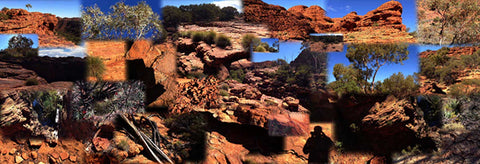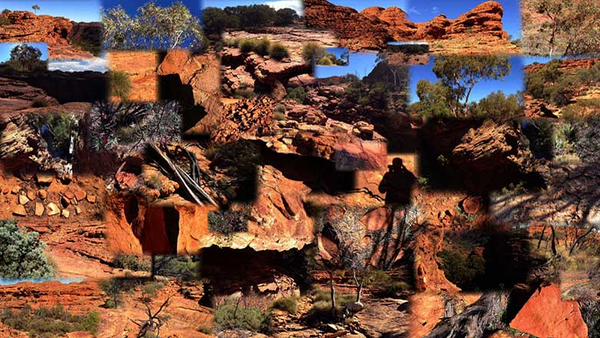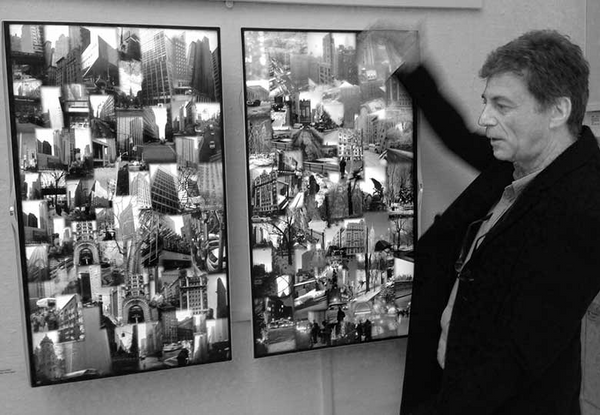RWA @ The Atkinson Galleries: Interview 3

In conjunction with RWA @ The Atkinson we asked some of the Academicians involved to answer a few questions about their current practice and what it means to be an Academician. Here, recent Academician Terry Flaxton give us some insights into his life as an artist:
RWA: What are you working on at the moment?
TF: I have a long term project which originated in the late eighties and it takes many forms. The base line though is that I have set myself the task of reimagining the representation of places, people and ideas – in other words the subject of the artists gaze - in way that hasn’t been done before, so that they are presented in a different way, so that they might be seen anew. Recently I’ve once again tried to re-imagine Venice which was made doubly difficult because it’s a subject that I return to again and again.
I made a previous work called ‘Un Temp Una Volta’ which loosely translated means ‘Once upon a time’ which was to infer that Venice occupies a role as part of the dream life of humanity in its inspirational position of evoking in equal measure love and nostalgia in the human psyche (and many other things). I had visited Cannaregio, a favorite part of Venice because it’s working class (and work actually happens there) and I made a portraiture project with the people of one of its districts district. In conversation at the exhibition of this work - I always try to give back to a community when I have effectively take something from them - it became clear that Venetians and principally their ambassadors, the Gondoliers, spend a lot of their time gazing at the sky, through the gaps created by the rising buildings. So I placed a camera in a boat looking upwards to create a 20 minute loop which was then projected on a 10 foot by 20 foot screen which was then suspended at an angle of 45% above the audience space, where a large soft bedding was placed for everyone to lie on – this was in 2008. Recently Pippilotti Rist used this technique at Hauser and Werth. I managed to demonstrate the presence of water without showing it, because it gently rocked the boat as we drifted along the canals. At each bridge I had people draping silks that were secondary colours sympathetic to the architecture, that filled the cameras viewpoint to then colour wash the image and infer the textile dealings of Venice over the centuries.
So with ‘Venice Reimagined’ to be exhibited at the Autumn Open, I obviously couldn’t go there again with that same technique – I chose to shoot 180 images which were composed across three screens to form a triptych entitled, not unsurprisingly ‘Venice Reimagined’. I hope you see this at the Autumn Open. But I tell you all of that because this project which is to travel towards a cubist representation of the world is forcing me to go to portraiture to create some of the first cubist portraits within Moving Image and I intend to capture the likenesses of the people that head Bristol’s Cultural Institutions.
I’ve also just finished a 70 minute single screen work called ‘Myth and Meaning in the Digital Age’ which I began in 1989 as a response to a programme on Channel four by a friend of mine which was called ‘’objet d’art à l’age éléctronique’ (thus echoing Walter Benjamin’s famous 1936 essay ‘The Object of Art in the Age of Mechanical Reproduction’ which essentially considered how much of the aura of an object of art can be contained within its reproduction (sat within prints of an original) – which within the age of the digital gains a pertinence that Benjamin may not have considered. For instance, if an object of art is created within the digital it could be said that there would be no difference between the original and the copy – and this is something that all artists deal with that work with non-tradition materials, the materials of ubiquity. So making a work about ubiquity has taken me 27 years to complete – now that’s ironic.
RWA: Where do you find inspiration?
TF: I’m very traditional in terms of inspiration: the masters of the forms for me always serve up inspirational gestures, whether Reubens or Goya Rothko or Picasso, medieval icon painters, Roman Mosaicists, Hokusai, and many unknown artists over the centuries – it doesn’t matter. Each in their on way are dealing with the fundamentals of the act of art which for me is about the artists gaze. Can anyone be an artist? Yes, is everyone an artist? No? So who is the artist and who not? First take up the brush and then you will find out. And when I say brush I mean a tool that inscribes marks in the world.
If you do conceptual art or performance art there may be no tool other than the mind. For me Marina Abramovic’s ‘The Artist is Present’ took up Hirst’s ridiculous challenge of the platinum skull which had said in its making ‘in the end the art market is about value in this age that knows the value of nothing and the price of everything, so here’s an object which literally is valued in its base constituents of platinum and diamonds, exactly the same as the work of art itself – and by the way the subject of this work is death and impermanence’ (I think Hirst is sometimes far too fascinated by his own clever boy image).
Abramovic stripped away everything that was contained within this false ideology and posited that the artists gaze and therefore the artists intent is that which matters. When she was ‘present’ so were we. If you think back to a portrait sitting in the late 15th century say, where the subject looks out of the painting at us the audience, then to obtain that image the artist must ask the subject to in fact stare at them. So they connect their gazes – artist and subject – and so in the representation of the subject if the artist is true in their depiction and their commitment to render the likeness not of the subject, but the subjects inner state, then what comes through the canvas (which becomes like a meniscus between two time periods) is the effect of exciting the mirror neurons of those that view this image and we then experience the energy of the subjects gaze, through the artist and through time. Of course, scientists argue that mirror neurons are those things within our brains which engage us in an empathetic act, but scientists are sometimes disingenuous about the verification of their assertions such that mirror neurons are like a contemporary ‘phlogiston’, a made up thing that answers a scientific problem. But, this is a best guess scenario and does not take away from the argument of the subjects gaze met first by the artist and then by us as viewer.
The artist Antonio Tapies claimed that the artist is the shaman who conducts the lightning strikes of inspiration and innovation to ‘the tribe’ – we the people. Put another way which takes account of new theories of empathy being wired in to our brains via the function of mirror neurons, the artist is the ‘cognitive distributive node’ which creates work to excite and inspire the minds of others. Modern art, and the materials of modern art are to do with the materials of communication and consciousness. As soon as I had discovered first sound then video, I put down my paint brush (I was originally a painter) and picked up the new materials. It is within these that I find inspiration in relation to the overall human project and the condition it finds itself within.
RWA: What does being an RWA Academician mean to you?
TF: What it will mean to me is to develop the initial concerns of those that formed it in 1844 but transformed to go beyond the trade and imperial concerns of the time. Bristol is busily becoming one of the world's centres for new ideas (another cognitive distributive node?), new forms of art, new works in new forms and yet also be the ambassador of long time human values of justice and tolerance. When I’m not wrangling with the inherited structure that is the RWA (necessarily because it always takes time for systems and structures to yield to the concerns of the present), then I talk to people outside the RWA as if it had become the thing that it can be: the protector of values that mean something to the human spirit within art but also the protector of values that envision that which is most valuable within the unavoidable tsunami of new technologies that are transforming society almost beyond recognition; to then shepherd those technologies and changes in, within time-honoured values. What it means to me actually at the moment is the sense that we could go a lot faster than we are in the acceptance of the world that we find ourselves within, but fundamentally beneath all of this is a sense of pride at being accepted first and foremost by fellow artists, all of whom know how hard it is to keep a day to day practice going.
RWA: Who is your hero?
TF: There are many but it would be an obscure list because what I value most is not the bucket list of artists that can be coined to prove cultural value, but those that struggle on the peripheries. To make anyone a hero requires the sacrifice of hundreds if not thousands of forgotten souls – and those are the real heroes.
RWA: If you weren’t an artist, what would you be?
TF: Everything I’ve ever done is about making art. So if I wasn’t an artist I would strive to be an artist. Since made my first film in 1971 and my first video in 1976, the careers I’ve had to have to make any kind of money were there to initially subsidise my art. From walking into an artists collective in 1977 and seeing that no one there knew how to operate the new video equipment and my thinking to myself, “were I a medieval painter I would know how to mix pigment and plaster, so I’d better learn this new medium, so where can I learn?” and then realizing that the film industry was where people knew how to mix their pigments but that have a different intent to me – then I realized I had to be clandestine in my gathering of money. And yet that too was informative because I was placed in a particular position to see the workings of the entertainment machine. And given that experimental moving image thought that narrative was anathema to making experimental work (primarily because it was the province of Hollywood) then I needed to find different forms within this time-based medium to create gestures that I at least could identify as having artistic intent. My early work took the situations I found myself within as my subject matter. I shot the making of Ridley Scotts commercials for Apple computers in 1983 and that material became the subject area of some work which won awards for its disclosure of the structures of power beneath the making of works that ‘sold’ the future to the population. I’m writing this on an Apple computer right now and really disagree with what Apple is doing in terms of paying taxes to governments – but problematically I also know that what Apple did in distinction from what Bill Gates did, released much of what we now identify as creativity within the computer and digital domain. Having said that, when Quantum computers break out of the labs they’re currently in, art will once more change because when working with them you inherently interact and change what they do. The human project is to intertwine its selfhood with whatever it manufactures – and its busy manufacturing it’s new limbs in the form of the control of the environment around it.
All of the careers I’ve had have supported the making of my art. Moving Image art is expensive – I subsidise it. Yes I get awards and sometimes my ‘business model’ is completely backwards – for instance I show my work in cathedrals because they have a huge footfall of people who know art in a classical sense (part of why they’re there is to see the gestures of human creativity through architecture – which is an essential part of the RWA’s remit of course) and in that exhibition of that work in that place with that intention (last year around 650,000 people saw my work in the Cathedral of St John the Divine in New York and in 2016 I have another exhibition there starting in October) then I manage to create further funding for my work to continue. Being an artist these days is a very complex business. Literally.
RWA @ The Atkinson runs until this Saturday, 15 October 2016, 9.30am - 5.00pm at The Atkinson Gallery, Millfield School, Street, BA16 0YD.
Gallery

